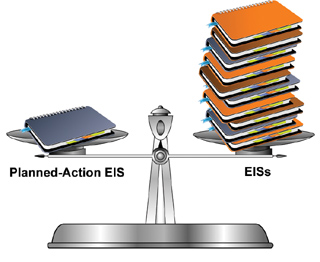
Surveys
DJC.COM
June 26, 2008
Speed up sustainable development with a planned-action EIS
AMEC Earth & Environmental

Harshman
|
Sustainable communities depend on development proposals that include low-impact, carbon-neutral and renewable strategies and materials in their designs. Defining specific kinds of sustainable practices in advance of specific development proposals will attract the right businesses to the development, resulting in an appropriately low carbon footprint.
In approving projects for development, a municipality must assess the sustainable character of each project and compare that to local sustainability goals. This whole process of sustainability assessment can be cumbersome, leading to multiple reassessments until compliance is achieved.
The procedure can be streamlined, though, through the planned-action environmental impact statement process.

Graphic courtesy of iStockphoto A planned-action EIS can eliminate a lot of paperwork associated with filing multiple EIS documents. |
Any significant project will require an EIS as part of its regular permitting process. A planned-action EIS allows a local jurisdiction to do an environmental review for a particular area that spells out the kinds of future development practices that will be acceptable for that area, such as green or low-impact practices. Subsequent development proposals that meet these criteria will be selectively attracted to these areas.
In 1995, the Washington Legislature authorized a new category of project action in the State Environmental Policy Act called a planned action. Designating specific types of projects as planned-action projects shifts environmental review from the time a permit application is made to an earlier phase in the planning process. The intent is to provide a more streamlined environmental review process at the project stage by conducting more detailed environmental analysis during planning.
Early environmental review provides more certainty to permit applicants with respect to what will be required and to the public with respect to how the environmental impacts will be addressed. More importantly, specific sustainability requirements can be spelled out in the planned-action EIS.
The future development of an entire area can be addressed as a planned action and reviewed in the EIS. Consequently, a proposed development that complies with the requirements of the EIS can be approved without having to go through its own SEPA process again. Local jurisdictions can use this process to include specific sustainability measures and requirements in proposed projects.
Another benefit of a planned-action strategy is keenly evident in the marketing of an area designated for development. Potential developments are actively on the lookout for viable sites. A major factor in deciding where to locate is ease of permitting and approval. Given a variety of locations that are physically more or less equal, sites that offer streamlined permitting and approval will win out. An abbreviated approval process translates into cost savings associated with predictable development requirements and a shorter time between design and ground breaking.
Initially, an EIS must be completed which addresses the likely significant adverse environmental impacts of development in the planned action area. After completing the EIS, the municipality with jurisdiction follows up by designating by ordinance or resolution those types of projects and businesses to be considered as appropriate planned actions, including the appropriate sustainability requirements that must be applied.
When a building permit application is subsequently submitted for a project that is being proposed in the planned action area, the municipality simply verifies that:
• The project meets the description of any project(s) designated as a planned action by ordinance or resolution.
• The probable significant adverse environmental impacts were adequately addressed in the original planned-action EIS.
• The project includes locally recognized and required sustainability measures outlined in the ordinance or resolution.
If the project meets the above requirements, it qualifies as a planned-action project. Once established, the planned-action review process can be used to attract new development to the area since new projects need only be reviewed for consistency with the designated planned action.
New business prospects will be attracted to the area since they will recognize that new operations can be quickly established and become quickly profitable. Importantly, sustainable development requirements and low-carbon emission strategies will be embedded into local planning and development procedures.
Gary Harshman, AMEC Earth & Environmental’s environmental planning manager in Kirkland, has more than 25 years of experience managing environmental planning programs throughout King and Snohomish counties. His recent projects have focused on developing planned-action EISs. Additional work has included sustainability planning, implementation, and auditing leading to funding source identification.
Other Stories:
- Corporate social responsibility turns green
- A green approach to gold mining in the Okanogan
- Financing evolves to benefit the environment
- Homeowners rethink their waterfronts
- Will Earthships save the Earth?
- Municipalities discover the benefits of eco-roofs
- What lies ahead for sustainable design?
- Planning our communities for a low-carbon future
- City, tribe team up on clean water project
- Architectural firm sets a zero-energy goal
- New stormwater discharge challenges loom
- Green building’s future lies in innovation, conservation
- Seattle becomes a hotbed for clean technologies
- Avoiding fish-related construction delays
Copyright ©2009 Seattle Daily Journal and DJC.COM.
Comments? Questions? Contact us.